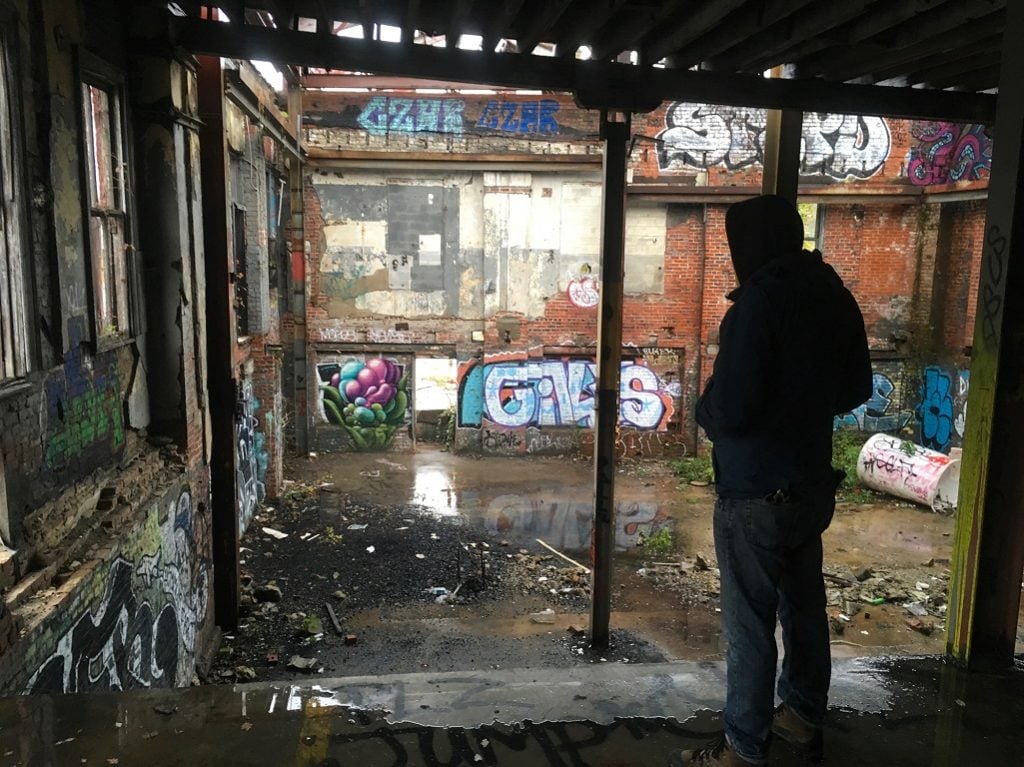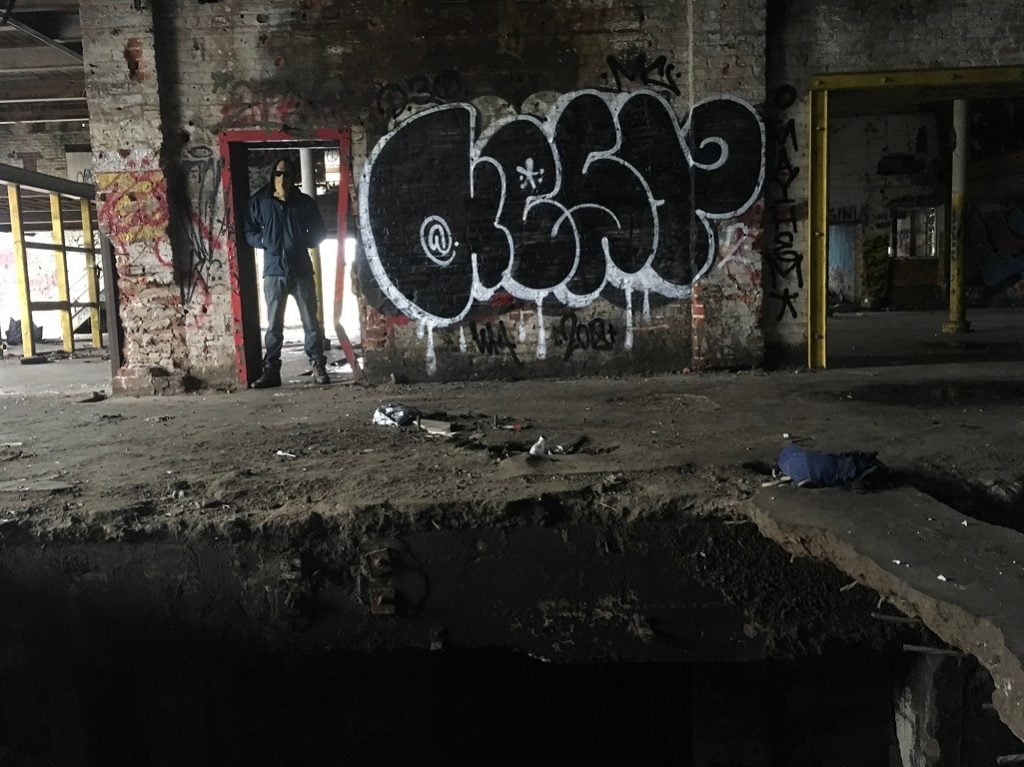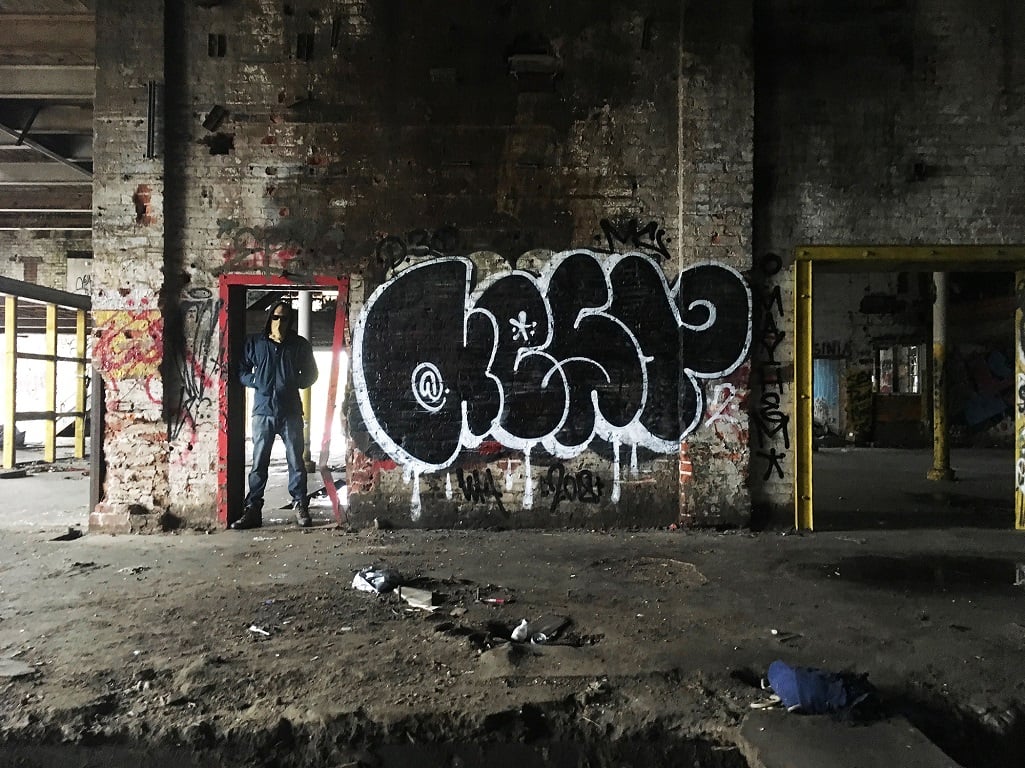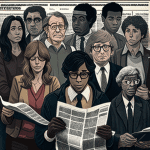*This article originally appeared in RVA Mag #37, on the streets now at all your favorite spots.
If you meet AEST2 in the course of an ordinary day, he seems like a normal citizen. But he leads a double life, furthering a decades-long graffiti career in secret. The majority of the city has no idea he exists, but within the tightly-knit local graffiti culture, he is Richmond-famous.
As the numeral indicates, AEST2 is not the original AEST. He took his name from a high school friend he used to skate and paint with. “He didn’t want to do graffiti anymore — and I liked those letters,” AEST2 says. “Also, that was around the time I got arrested for my old word.”
Your word — the series of letters graffiti artists paint as their signature, also known as your tag — is your name in the graffiti world. But when the police catch on, there’s only one way to stay in the game. “I got arrested for my old word,” AEST2 says. “So, write something new.”
AEST2 is Richmond-born and Richmond-raised, and joined the local graffiti culture as a teenager in the early 90s. At the time, before the days of VCU’s expansion and Venture Richmond’s local takeover, there was a lot of graffiti happening in Richmond. “A lot of legal walls, a lot of tagging,” says AEST2. “Not many people do throw-ups or straight letters [tags] anymore. Until the early nineties, people were just doing tags, really.”
“Tagging” is the act of writing your word, your name, on a wall in stylized letters, as fast as possible in as public a place as possible. People who do this are known within graffiti culture as “writers” or “bombers”; it’s less about art than it is about making sure people know who you are. “Throw-ups” are a bit more complex, but still designed to be quick — up and done before the cops come.

But legal walls, those are another thing. “A permission wall,” AEST2 explains. “Where the building owner is like, ‘You can paint on my wall.’ There were a good handful of those.” The forerunner to today’s many local murals, the legal walls of 1990s Richmond were often host to elaborate “pieces,” which resembled murals, and were sometimes created by entire multi-artist “crews” working together. They looked great, and there was always something new to see. If you ask AEST2, though, the permission walls were a victim of their own success.
“Towards the end of the nineties, people discovered throw-ups and fill-ins, doing BIG shit on the street,” he says. “I feel like that was the downfall of the legal walls.” While a huge wall filled with an elaborate, colorful graffiti piece might seem like a wonderful work of public art to artists and fans, the majority of property owners in Richmond’s slowly-gentrifying Fan neighborhood had a different take.
“Richmond used to be very conservative, as far as art in the public space,” AEST2 says now. “There was the Fan District Association saying this art was ruining everything. There was a push from them and others to get rid of it all. So the legal walls were all painted over, because it was going to scare people.”
This was around the same time that Mayor Rudy Giuliani received a great deal of acclaim for implementing what’s known as “broken-window policing” in New York City, cracking down on public drinking, subway fare evasion, and, of course, graffiti. An early success of New York’s broken-window campaign was the permanent end to graffiti on the subways — which pleased property owners and well-off corporate businessmen, but felt bittersweet to those who saw the graffiti art in New York City’s subways as a grassroots urban art movement.
Where Richmond’s own graffiti crackdown is concerned, AEST2 is more philosophical today. “The broken window theory and all that shit, I get it,” he says. “But as teenagers, you’re not thinking about that.”

He describes his own mindset at the outset of his graffiti career: “This shit is fun. Let’s go do this. Nobody is telling us what to do — we can do anything. It’s freedom. Pure freedom. I’m gonna write on this, I’m gonna write on that. Whatever. You’re not thinking, ‘Who owns this wall?’”
As a teenager, AEST2 was encouraged to get into art by his parents. However, they were less than pleased about his choice to focus on graffiti — especially after his first arrest. “They saw value, but at the same time, [they said], ‘You can’t go around writing on stuff that doesn’t belong to you.’ Like any parent should.”
That arrest wasn’t enough to stop AEST2, but it did teach him an important lesson: “Be a little more careful,” he says.
Graffiti is generally associated with hip hop — it’s one of the “five elements of hip hop” set out at the dawn of that movement by DJ Kool Herc and Afrika Bambaataa. However, in early 90s Richmond, it was strongly associated with skateboarding and hardcore punk.
“I learned about writing through skateboarding,” AEST2 says. “In Virginia, it’s connected to the hardcore scene. Going to punk and hardcore shows — that’s where all the writers were.”
At that time, before the big graffiti crackdown of the late 90s, fights between straight edge graffiti artists and those who dabbled in various substances were the biggest issue in Richmond. AEST2 was on the latter side. “I was hanging with the kids smoking weed, getting drunk, trying to eat acid,” he says. “All the bigger known writers were all straight edge kids, calling us fuck-ups and causing beef. People got into fights over it — it was a big deal.”
AEST2 tried to stay out of all that and just paint. “I would rather just do my own thing and not be fucked with because I want to smoke weed,” he says. “There were a lot of straight edge kids back then — it was very popular. Most of them are not straight edge anymore, but obviously years have gone by.”

When the crackdown came, though, all of the artists took notice. It went beyond street beef. The late 90s and early 00s saw some of Richmond’s most prolific graffiti artists — including those like Mickael Broth, who are well-known legal muralists in Richmond today — go to jail for their graffiti-related activities. And if property owners’ rights weren’t enough to make the young artists of the 90s think twice, the arrests definitely were.
“I was definitely paranoid about it,” AEST2 says. “You do stuff in the street that’s noticeable, and it’s on somebody’s property. The property owner’s pissed. They call the police to complain about it. So the police are getting pressure from people… [and they] start cracking down by creating a task force to find out who’s writing on everybody’s shit. ‘We’ve got to arrest these people and lock ‘em up! Put an end to this!’”
The law-enforcement campaign against graffiti has had a big impact on Richmond’s graffiti scene over the past two decades. “I have seen a lot of people come and go,” AEST2 says. “People go hard for a couple of years and then get a real job. ‘I got a career now. I’m not fucking with that — risking my awesome job and getting arrested for no reason.’”
That said, the local scene never entirely died. “[The crackdown] pushed a lot of people to start painting freight [trains] in Richmond, because it was way more low-key,” AEST2 says. “And [the train was] gone the next day. What you did in the [local] yard is now in Pennsylvania or Florida somewhere.”
The gentrification of Richmond has also made it harder to find local spots to paint. “There was a lot more stuff to paint back then,” says AEST2. “More abandoned buildings, and the city wasn’t as fancy. Now there are new condos everywhere, lots of new restaurants. Which is great, but it’s not the same.”
But there’s still graffiti visible around Richmond — if you know where to look. “I don’t think it ever went away, just… people grew out of it,” AEST2 says. “There’s not a lot of payoff in it. People that enjoy it and get something out of it stick with it. And there’s new generations of art kids every year.”
Legally-created murals have also become a much more accepted form of public art in recent years; campaigns like the Richmond Mural Project and the RVA Street Art Festival have fought back against an epidemic of flat gray walls. AEST2 may be on the illegal side of the street art movement, but he appreciates the murals as well. “Everyone [is] more open to art in general now that street art is so popular,” he says. “They might be more accepting of graffiti.”
But legal murals will never replace the illicit art of graffiti. “It’s illegal — that’s the point of it,” says AEST2. “When it’s legal, that takes away a huge part of what it’s about.”

AEST2 insists that, regardless of legality, graffiti and street art are two different things. “Street art is more accessible than some letters people can’t read.” However, those “letters people can’t read” are a fundamental component of graffiti — one that can’t be separated from easily-appreciated murals. “People always want to know, ‘What does it say? What does it mean?’” he explains. “At the end of the day, it doesn’t really mean anything. It’s a nickname, and you want to stylize these letters and make them look cool.”
“Then there’s the whole tagging vs. pieces thing,” AEST2 continues. He sarcastically imitates the fans of murals who doesn’t “get” graffiti: “‘Oh, I like the colorful stuff, but the writing is terrible! Why would you do that?’”
This argument frustrates AEST2, because it indicates a fundamental misunderstanding of graffiti art and its evolution into colorful, aesthetically-pleasing murals. “That’s where it comes from,” he says. “Tagging [is] the initial phase of it. That’s what you base your whole letter structure on. You do that first, and then progress.”
Indeed, it was doing graffiti that taught AEST2 to be an artist. “I sucked like everyone else when I started,” he says. “But you paint more and you learn things. I ended up learning color theory. The more I did it, the more fun I had doing it.”
And in the depths of this secret life, he also found a community. “I met other people that liked doing it and it ended up becoming a social thing,” he says. “I met all kinds of people that I would not have met otherwise — connections in other states and cities. It was our own little bubble. Our own secret fraternity. A bunch of anti-social socialites.”
Interview and Photos by R. Anthony Harris, story by Marilyn Drew Necci



